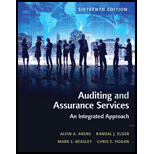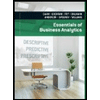
Auditing and Assurance Services, Student Value Edition (16th Edition)
16th Edition
ISBN: 9780134075754
Author: Alvin A. Arens, Randal J. Elder, Mark S. Beasley, Chris E. Hogan
Publisher: PEARSON
expand_more
expand_more
format_list_bulleted
Question
Chapter 15, Problem 33DQP
a.
To determine
State the way Person A should interpret CUER 7.92%
b.
To determine
State the reason for making the Person A to conclude about the effectiveness of the control based on one attribute deviation.
c.
To determine
Provide the alternatives to be used by Person A to determine that control cannot be relied.
d.
To determine
State whether the information gathered from the controller will be helpful for Person A to ascertain the information will be more relevant for discussing the alternatives in the requirement c and also explain the type of testing and documentation that would be used in order to conclude that the control can be relied upon.
Expert Solution & Answer
Want to see the full answer?
Check out a sample textbook solution
Students have asked these similar questions
Solve this question and accounting
Please provide the answer to this financial accounting question using the right approach.
Evergreen Systems purchased machinery for $92,000 on January 1, 2020. Additional costs included $4,500 in delivery charges and $8,000 for installation and setup. The machinery is expected to have a salvage value of $20,000 at the end of its 4-year useful life. What is the amount of accumulated depreciation on December 31, 2021, using the straight-line method?
Chapter 15 Solutions
Auditing and Assurance Services, Student Value Edition (16th Edition)
Ch. 15 - Prob. 1RQCh. 15 - Prob. 2RQCh. 15 - Prob. 3RQCh. 15 - Prob. 4RQCh. 15 - Prob. 5RQCh. 15 - Prob. 6RQCh. 15 - Prob. 7RQCh. 15 - Prob. 8RQCh. 15 - Prob. 9RQCh. 15 - Prob. 10RQ
Ch. 15 - Prob. 11RQCh. 15 - Prob. 12RQCh. 15 - Prob. 13RQCh. 15 - Distinguish between the TER and the CUER. How is...Ch. 15 - Prob. 15RQCh. 15 - Prob. 16RQCh. 15 - Prob. 17RQCh. 15 - Prob. 18RQCh. 15 - Prob. 19RQCh. 15 - Prob. 20RQCh. 15 - Prob. 21RQCh. 15 - Prob. 22.1MCQCh. 15 - Prob. 22.2MCQCh. 15 - Prob. 22.3MCQCh. 15 - Prob. 23.1MCQCh. 15 - Prob. 23.2MCQCh. 15 - Prob. 23.3MCQCh. 15 - Prob. 24.1MCQCh. 15 - Prob. 24.2MCQCh. 15 - Prob. 24.3MCQCh. 15 - Prob. 25.1MCQCh. 15 - Prob. 25.2MCQCh. 15 - Prob. 25.3MCQCh. 15 - Prob. 27DQPCh. 15 - Lenter Supply Company is a medium-sized...Ch. 15 - Prob. 29DQPCh. 15 - Prob. 30DQPCh. 15 - Prob. 31DQPCh. 15 - Prob. 32DQPCh. 15 - Prob. 33DQPCh. 15 - Prob. 34DQPCh. 15 - Prob. 35DQPCh. 15 - Prob. 36CCh. 15 - Prob. 37ICA
Knowledge Booster
Similar questions
- I am looking for the correct answer to this financial accounting problem using valid accounting standards.arrow_forwardSweet Dreams Mattress Co. has assets of $750,000 and turns over its assets 2 times per year. Return on assets is 15%. What is its profit margin (return on sales)?arrow_forwardGeneral accounting questionarrow_forward
- Financial Accountingarrow_forwardPlease give me correct answer this financial accounting questionarrow_forwardCorvex Industries had sales of $620 million last year, and its production facility operated at 80% of capacity. The actual amount of fixed assets was $250 million. What total amount of fixed assets will Corvex need if it plans to increase sales by 30%? Solve this Accounting problemarrow_forward
arrow_back_ios
SEE MORE QUESTIONS
arrow_forward_ios
Recommended textbooks for you
 Auditing: A Risk Based-Approach (MindTap Course L...AccountingISBN:9781337619455Author:Karla M Johnstone, Audrey A. Gramling, Larry E. RittenbergPublisher:Cengage Learning
Auditing: A Risk Based-Approach (MindTap Course L...AccountingISBN:9781337619455Author:Karla M Johnstone, Audrey A. Gramling, Larry E. RittenbergPublisher:Cengage Learning Essentials Of Business AnalyticsStatisticsISBN:9781285187273Author:Camm, Jeff.Publisher:Cengage Learning,
Essentials Of Business AnalyticsStatisticsISBN:9781285187273Author:Camm, Jeff.Publisher:Cengage Learning,

Auditing: A Risk Based-Approach (MindTap Course L...
Accounting
ISBN:9781337619455
Author:Karla M Johnstone, Audrey A. Gramling, Larry E. Rittenberg
Publisher:Cengage Learning

Essentials Of Business Analytics
Statistics
ISBN:9781285187273
Author:Camm, Jeff.
Publisher:Cengage Learning,